101 Facts Reindeer & Deer
…Amazing Animal Books
Over 101 cool facts in this kids book about some of the most graceful animals in the world. It has great images and facts about these beautiful creatures.
101 Facts… Reindeer & Deer by IP Factly
Contents
Introduction
General Deer Facts
Deer vs. Antelope
Evolution
Notable Extinct Species
Anatomy & Senses
Antlers
Reproduction
Diet
Reindeer or Caribou
Moose
Muntjac
Other Notable Species
Deer & Humans
Final Facts
Photo Credits
Introduction
Gentle, graceful and majestic, deer can be found in many parts of the world. While they are often preyed upon by other animals where they live, this fact only makes them a very important part of nature. Sadly, they are also often hunted by humans for sport and for their meat, which is why many have become extinct, and many, too, are now endangered.
General Deer Facts
Deer are mammals belonging to the family Cervidae. They are also called cervids. The adjective cervine means ‘deer-like’.
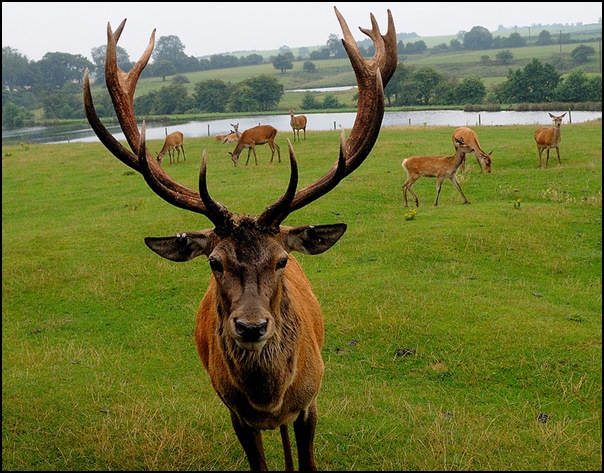
Red Deer by chapmankj75
Deer are ungulates. This means that they stand and walk on the tips of their toes, which are hoofed. In particular, they are even-toed ungulates or artiodactyls, their body weight supported equally by their third and fourth toes.
Deer can be found on every continent except Antarctica. They are not native to Australia, though, and were only introduced there by settlers. Most deer species can be found in Eurasia.
Deer occupy a wide variety of habitats. They are found in tropical forests, in icy tundras, in alpine meadows, on rocky mountain slopes and in dense forests.
Deer are social animals. They live in families consisting of a female deer and her young or in larger groups called herds.

Antlers by internets_dairy
A male deer is called a buck and is also sometimes called a stag or a hart, especially if it is large with imposing antlers. A female deer is called a doe or a hind and a young deer is called a fawn.
Deer have relatively short lifespans, ranging from 3 to 14 years. Only a small percentage of deer make it past their first year due to predation, accidents, diseases and starvation.
Deer have numerous predators including wolves and coyotes, wild cats like bobcats, cougars, lynxes and jaguars, and bears, wolverines and even alligators. In addition, fawns are also taken by birds of prey.
Deer vs. Antelope
Deer and antelope may look similar but they are two different animals. While deer belong to the Cervidae family, antelopes belong to the Bovidae family, which also includes bison, sheep, goats and domestic cattle.
There are about 62 species of deer scattered throughout the world. On the other hand, there are 91 species of antelope, most of which can be found in Africa, where there is only one native deer species.
Both female and male antelope can grow antlers, whereas in most deer species only males grow them. The antlers on an antelope are permanent whereas deer antlers are shed every year.
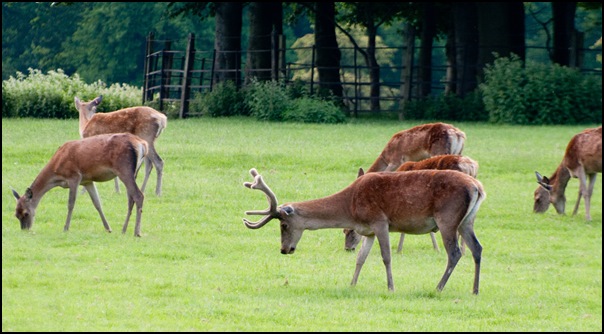
Oh Dear! by DarrelBirkett
Evolution
The first hoofed animals appeared roughly 54 million years ago during the early Eocene period. They were small, short-legged creatures who ate mostly the leaves of plants.
Eight million years later, during the late Eocene, the artiodactyls were divided into three groups – the Suina group, consisting of pigs, the Tylopoda group, consisting of camels and the Ruminantia group, the largest group which would be later be divided into goats, cattle, sheep, deer and antelope.
The archaeomeryx, which lived 35 to 40 million years ago, is believed to be one possible ancestor of today’s modern deer. It was a rabbit-like creature no bigger than a mouse!
For millions of years, artiodactyls were beaten by the perissodactyls, or odd-toed ungulates, such as rhinos and horses, in the competition for food, and driven out of places with the most nutritious plants. However, in the Miocene period roughly 20 million years ago, grass became widespread and the artiodactyls, that could digest grass better, became more numerous, taking their place as the dominant herbivores on land.
Notable Extinct Species
The Dicrocerus elegans was the first known species of deer to have antlers. It appeared roughly 10 million years ago and went extinct 5 million years ago.

Dicrocerus elegans antlers, collection – Edouard Lartet
Eucladoceros is an extinct genus of deer which was best known for its spectacular well-branched antlers which measured 5.6 feet (2 meters) from tip to tip. They lived from about 3.6 million years ago to about 50,000 years ago.
The broad-fronted moose is believed to be the largest deer ever to have lived. It stood about 6 feet 11 inches tall (2 meters) at the shoulder and weighed as much as 2645 pounds (1200 kilograms). It lived during the Pleistocene epoch, up until 11,700 years ago.
The Irish Elk, which became extinct roughly 7,700 years ago, had the largest antlers of any deer, measuring 12 feet (4 meters) from tip to tip and weighed up to 88 pounds (40 kilograms). It was also a very large deer, standing over 6.5 feet (2 meters) tall at the shoulder.

Irish Elk by Sterilgutassistentin
Anatomy & Senses
Deer have only lower teeth, their upper teeth being replaced by a tough, padded, upper jaw which is an adaptation for their herbivorous diet. They have an average of 32 teeth.
Deer hooves are made of the same material that makes up our fingernails, but it is much thicker and stronger, hard enough to dig through the soil and snow in search of food. Each hoof is divided into two segments to distribute the deer’s weight.

Deer hoof by Joachim Bäcker
Deer have compact bodies and slender but powerful legs that allow them to run across rough terrain. They can run at speeds of 30 to 40 miles (48 to 64 kilometers) per hour.
Deer are also excellent jumpers. They can jump over obstacles up to 12 feet (4 meters) high in a single bound and over distances of up to 30 feet (9 meters).
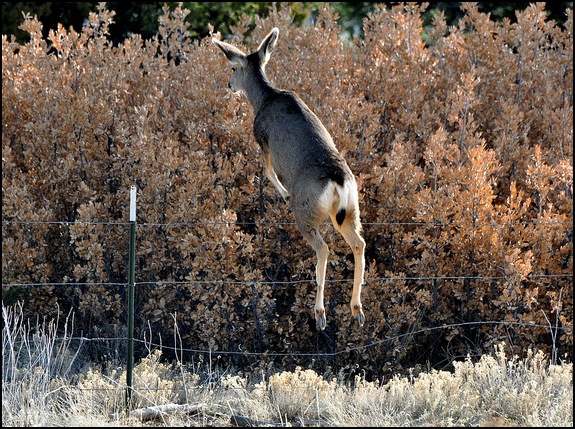
Deer Jumping Over Fence by Larry Lamsa
The eyes of a deer have plenty of rod cells but few cone cells. This means they can see better at night than during the day. They also have a layer called the tapetum lucidum which enhances their night vision.
Deer have scent glands in front of their eyes which they use to mark their territory. They rub their faces against brushes or trees, leaving their scent to inform other deer of their presence in the area. Mother deer also rub their faces on their fawns in order to easily identify them.

Deer by rumpleteaser
Deer have nine other scent glands located all over the body – one on the forehead, two outside the hind legs, two inside the hind legs and four more glands between the toes. When a deer stomps its feet, it is actually rubbing its scent into the ground.
Deer have a good sense of smell, some say a thousand times better than our own! Like dogs, they lick their noses often to keep them moist. This allows the scent particles to stick to their noses better.
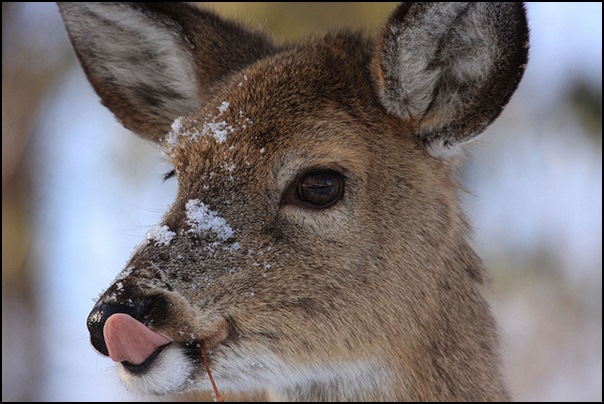
Taste of snow by Craig Lewis/USFWS
Apart from their noses, deer have a special organ inside the roof of their mouths called the vomeronasal organ or Jacobson’s organ. This acts as a second smelling organ, helping the deer literally taste what is in the air.
Deer have even more excellent hearing. They can hear more frequencies than humans and turn their ears in any direction to pinpoint where the sound is coming from.
Most deer species have brown coats which provide them with excellent camouflage. Some, however, have a brown and white coloration, and are called piebald deer. Piebald deer also tend to have overly arched spines and long tails.
White deer also exist as a result of albinism – the absence of pigment in skin and hair – or a recessive gene. The largest population of white deer can be found in New York.

Albino Barren Ground Caribou at Wagon Trails Animal Park by Brian0918
Deer have a thin summer coat and a thick winter coat, shedding once a year between seasons.
Antlers
Antlers are the bony structure on top of a deer’s head. Antlers are the fast growing bones in the world – able to grow from ¼ of an inch (1 centimeter) to a whole inch (3 centimeters) per day.
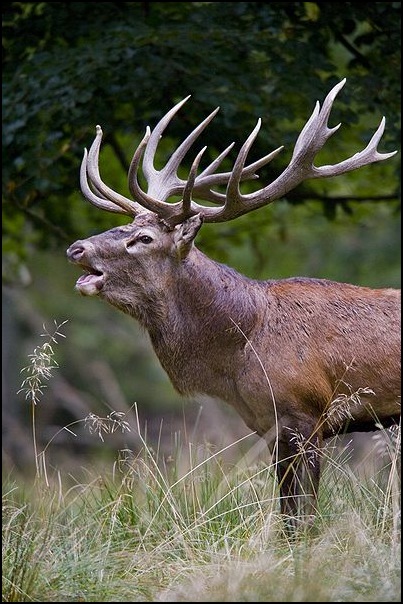
Red deer stag in Denmark by Bill Ebbesen
Antlers are different from horns, like the horns of sheep, goats and cows. Horns are not shed, but grow with the animal, often having rings to indicate the animal’s age. Once broken, they cannot grow back.
A deer’s antlers, however, are shed every year, particularly in winter. Then, from spring until fall, they are grown again. Deer are the only animals that can regenerate their bones.
Deer antlers are covered with a soft tissue called velvet. This tissue contains nerves and blood vessels, making them very sensitive to the deer’s environment.

Velvet antlers of a red deer stag by Mehmet Karatay
Contrary to popular belief, deer do not rub their antlers against trees to shed the velvet. Rather, most of the ‘antler rubs’ occur when the velvet has been shed, and are made to mark territories.
From spring to early summer, the antlers of a deer are soft and spongy. They are not suited for fighting and so bucks try to avoid each other as much as possible during this time.
In fall, the velvet dries and falls off and the antlers harden. The shed velvet is often eaten by the buck or other deer since it is a rich source of protein.

Fallow deer with antler velvet peeling off by Stefan Ivanovich
A buck first grows his antlers between one and one and a half years of age. As it grows older, its antlers grow bigger as well, but they stop growing, or growth declines, at around seven years.
Some bucks do not shed their antlers due to a genetic defect or a health problem. New bone and new velvet are grown each year and as a result, the antlers look like a cactus, giving these bucks the name ‘cactus bucks’.
Apart from the buck’s age, the size of the antlers also depends on the buck’s nutrition. Properly nourished bucks have larger antlers than malnourished ones.

A red deer stag’s antlers covered with grass by Martin Falbisoner
The base from which antlers grow is called a pedicel. These appear as bumps on the head, which females also have. The reason most female deer do not grow antlers is not because they do not have the bone structure but because they do not have the testosterone which enables the antlers to grow.
The sharp point on a deer’s antler is called a tine. The tine closest to the deer’s head is called the brow tine while the tine at the very top of the antlers is called the crown tine.
Reproduction
Because deer have a relatively short lifespan, they mature quickly. Most deer species are able to reproduce between one and one and a half years of age.
The breeding season for deer occurs during the winter months October and January and is called the rut. During this time, a buck gathers his own group of females to mate with and fiercely defends them against other bucks.

Red Deer at Ashton Court, Bristol, UK by Andrew Bennett
After mating, does carry their young for six to eight months. They give birth to one or two fawns, who can weigh anywhere from 5 to 8 pounds (2.2 to 3.6 kilograms).
Fawns are able to see as soon as they are born and are able to stand and walk within a few hours. They are still wobbly, though, and cannot walk for long distances.
Fawns are born with four baby teeth and develop more in the next few months. Their adult teeth come in around 18 months.
Most fawns are born covered in white spots. These spots disappear around eight to nine months, allowing the fawn to better hide itself.

Muntjac Deer Fawn (less than two hours old) by Peter Trimming
During the first three months, fawns have no scent, which provides them protection from predators. How their mothers are able to find them remains a mystery.
A doe cares for her young all on her own. In the first few weeks, she leaves her young in a thicket or behind bushes to keep them safe, checking on them and nursing them about six times a day. Sometimes, the fawn does not want to be left behind and the mother has to push it down gently with her foot.

Fawn Under a tree by Walter Mains
Fawns emerge from their hiding place when they are already strong enough to run and accompany their mother everywhere, and can stay with their mothers for up to two years. The term ‘fawn’ is only used for deer less than a year old.
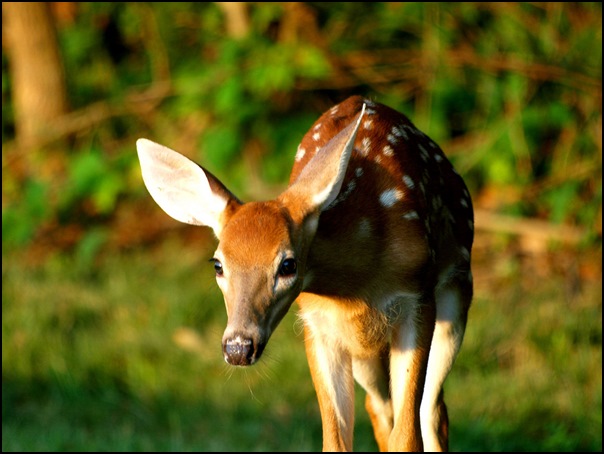
A curious fawn on the meadow by LouisvilleUSACE
Diet
Deer are herbivores, or plant-eating animals. Some of them are browsers, mostly feeding on leaves that they can reach, while others are grazers, eating mostly grass. Apart from leaves and grass, deer eat berries, acorns, nuts, mushrooms, herbs and wild fruit.
Deer are ruminants just like goats and cattle. What this means is that their stomach is divided into four chambers. Everything they eat is stored in the first chamber, and then while they rest, the food is moved to the second chamber, where the solid parts are separated from the liquid parts. The solid part is mixed with saliva and formed into a clump called cud. This cud goes back to the deer’s mouth to be chewed some more and is then passed on to the third chamber, where true digestion takes place. Finally, the digested food is moved to the fourth chamber where the nutrients are absorbed.

Deer at Work by Earl McGehee
Like horses and elephants, deer have no gallbladder, the organ which stores the bile produced by the liver. Again, this is an adaptation for their herbivorous diet. Since they eat mostly plants, there is no need for them to store the bile which breaks down lipids from meat.
Deer do not hibernate but they do eat less in winter, mainly because there is less food available. In order to get by, they also become less active, and stay in the woods more.
Reindeer or Caribou
The caribou, also commonly called reindeer, are large deer that play an important role in the lives of the people who hunt them or raise them in farms for their meat or for transport. In Lapland (an area of Norway, Sweden, Finland and Russia), instead of dogs, it is the caribou that pull the pulks or sleds and in Scandinavia, reindeer meat is very popular, commonly made into meatballs or sausage.
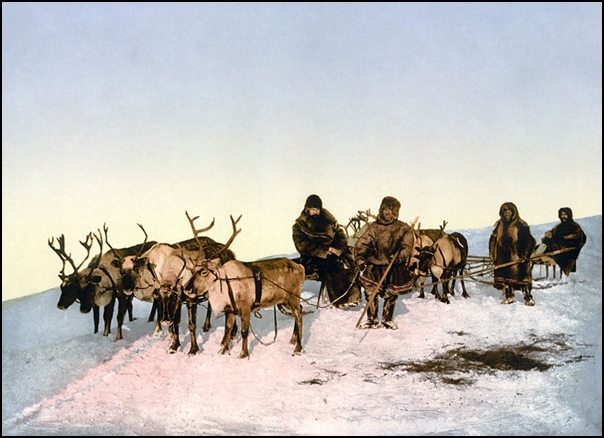
Archangel reindeer 1890-1900 by Detroit Publishing Co.
Caribou have two layers of fur that protect them from the harsh cold. The coat is brown – dark brown for those that live in southern areas and light brown, nearly white, for those that live in northern areas.
Caribou are unique, in that usually both males and females of the species grow antlers. In Scandinavia, the bucks’ antlers fall off in the winter while the does’ antlers fall off in the summer.
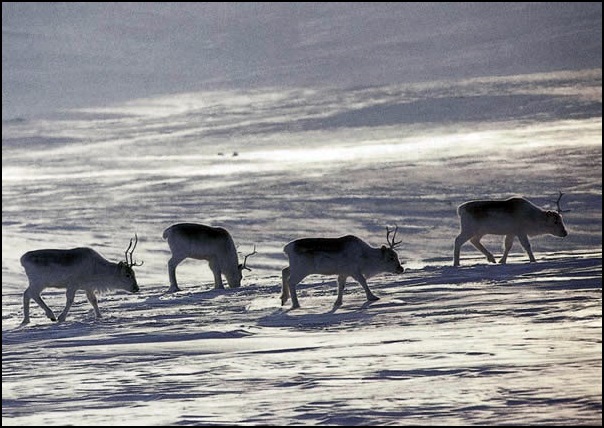
Peary caribou by L. David Mech NOAA
The hooves of a caribou change to adapt to the season. In summer, they are soft and sponge-like and in winter, they shrink and harden, cutting into the ice and snow to prevent them from slipping and allowing them to dig in search of food.
Caribou are herbivores like the rest of their kind, mostly eating reindeer moss which other animals find hard to digest, but when food is scarce, they will also feed on lemmings, on fish and on bird eggs.
Some caribou, especially those in North America, migrate in spring, from their foraging grounds to their breeding grounds. They can cover a distance of 3,100 miles (5,000 km) each year, traveling farther than any other land animal.

Reindeer by Bjørn Christian Tørrissen
Caribou are good swimmers. They can swim for up to 6 miles (10 kilometers) per hour, and during migration will not hesitate to cross broad lakes and rivers.
Moose
The moose is the largest species of deer, and is also known as an elk in Eurasia. The Alaska moose, the largest subspecies, can stand over 7 feet (2.1 meters) at the shoulder and can weigh over 1386 pounds (630 kilograms).
Moose also have the largest antlers of any living deer, which can spread up to 6 feet (1.8 meters) across.
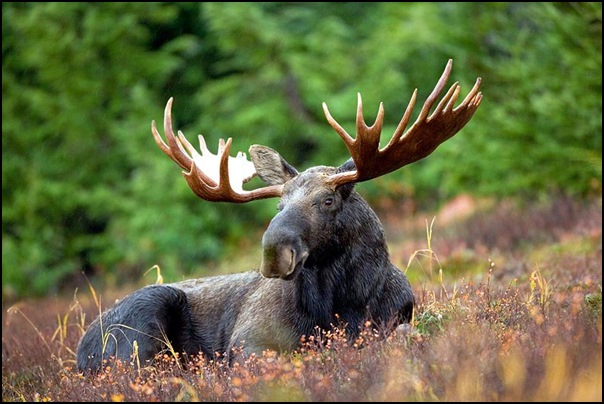
A male moose takes a rest in a field by Hagerty Ryan, USFWS
Unlike most deer, moose are solitary, only coming in contact during mating. Even young moose leave their mothers to fend for themselves at an early age, usually around 10 months.
Moose can eat as much as 71 pounds (32 kilograms) of food a day. They mostly eat forbs (herbs other than grass) and shoots that grow on willow and birch trees, as well as aquatic plants. Moose are the only deer which can feed underwater.

Bull Moose by images.fws.gov
Usually, moose are not aggressive toward humans but they can charge when frightened or startled, especially during the breeding season. They can be very dangerous when charging, and have been known to fend off wolves and bears!
Muntjac
The muntjac is the oldest known deer, first appearing as early as 35 million years ago. Many of its species have become extinct but 12 currently remain.
Unlike most deer, muntjacs have no seasonal rut. Rather, they can breed and give birth at any time of the year, usually after a gestation period of 7 months.
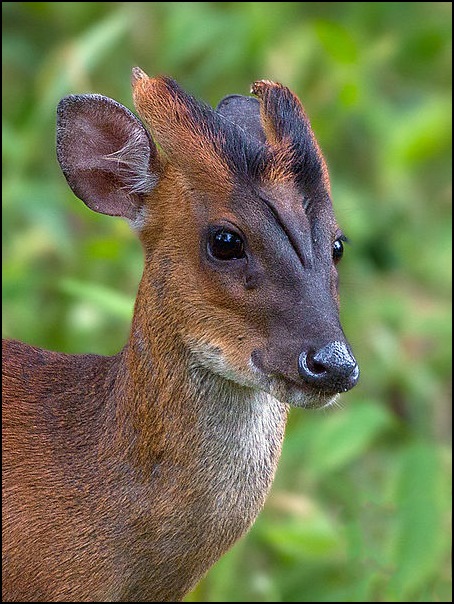
Indian Muntjac in Nagarahole Forest, India by Subramanya CK
Male muntjacs have short antlers, hardly suitable for fighting. Muntjacs fight instead using their tusks, or downward-pointing canine teeth.
Muntjacs are also known as ‘barking deer’ because of the repeated, loud barking sound they make when they sense danger. This sound is usually produced more loudly by males than females.
Other Notable Species
The elk is one of the largest mammals in North America and eastern Asia, standing 4.3 feet (1.3 meters) at the shoulder. It is also called the wapiti and is not to be confused with the moose.
Elk or wapiti live in herds throughout the year – composed of one male and multiple females during breeding season, and of all-male and all-female herds the rest of the year. In order to attract females when breeding season comes around, elk dig holes in the ground which they spray with urine before rolling in them.

Rocky Mountain bull elk in Nebraska by MONGO
The pudu is the world’s smallest deer. It can only grow up to 18 inches (45 centimeters) tall and weighs at the most 30 pounds (13 kilograms). Newborn pudus weigh only about 31 ounces (890 grams) at birth.
The red deer is the fourth largest deer species, weighing up to 530 pounds (240 kilograms) and is widespread throughout Europe. Some male deer of this species can produce a roaring sound, which they do to keep their females together during the breeding season.

Red deer stag in Glen Torridon, Scotland by Mehmet Karatay
The sambar deer, found in India and southeast Asia, is the third largest deer species in the world. It can reach a height of 63 inches (160 centimeters) at the shoulder and can weigh as much as 1204 pounds (546 kilograms).
The sika deer, which lives in eastern Asia, is one of the deer species that retains its spots throughout its lifetime. The spots become less prominent in winter, when their coats become shaggy and dark.
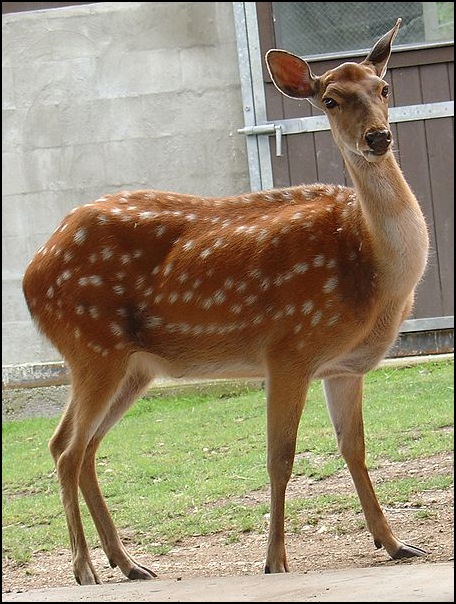
Formosan Sika Deer by Tempshill
Water deer are small deer found in China and Korea, that are sometimes called ‘vampire deer’. They do not have antlers, instead having tusks like tufted deer and muntjacs. Their tusks are the longest, growing over three inches (8 centimeters) long. It is because of their tusks that they have also been called ‘vampire deer’.
The white-tailed deer is the most common deer found in North America, and is also found in Central and South America. It gets its name from the white underside of its tail, which it raises when there is danger.
Like muntjacs, tufted deer also have very small antlers which can hardly be seen. They have long canines, though, which can grow up to an inch (3 centimeters) long.

Tufted Deer, mature male with small tusks by Heush
Brocket deer can be found in Central and South America, and are known for being nocturnal and very shy. Unlike most deer, they are solitary or live in pairs, with mated pairs mating for life.
Indian hog deer have stout, solid bodies instead of slender ones, hence their name. When running through the forest, they also hang their heads low in order to duck under obstacles, instead of leaping over them like other deer.
Fallow deer are widespread throughout Europe and are especially common in the United Kingdom). In the first two years, bucks have only a single spike for their antlers but afterward, have shovel-shaped antlers.

Fallow deer at Avon Valley Country Park, England by Adrian Pingstone
Marsh deer are the largest deer species in South America. They can reach a height of 3.9 feet (1.2 meters). As their name implies, they leave near marshes or aquatic habitats, and eat mostly aquatic plants which they pull out of the water.
Deer & Humans
The Celtic people considered deer sacred and even called them ‘fairy cattle’. They believed that a fairy giantess personally took care of the deer and set apart those that the people could hunt.
Cernunnos was a god in Celtic mythology that had deer antlers. He was known as The Lord of the Forest, The Stag Lord and The Lord of The Hunt.
In Greek mythology, deer are associated with Artemis, the goddess of the hunt. In one tale, she discovered a human hunter named Actaeon watching her while bathing and enraged, turned him into a stag. His own hounds then turned on him and tore him apart!

Actaeon in Caserta by japiot
In Norse mythology, four stags feed on the leaves of the Yggdrasill, the tree that sustains the nine worlds. What the four stags stand for is unknown, although some speculate that they stand for the four elements, the four seasons or the four phases of the moon.
St. Giles, who is revered in southern France, lived many years as a hermit. During his isolation, it is reported that his companions were deer, some of which gave him milk to sustain him.
In Hindu mythology, Saraswati, the goddess of learning, sometimes takes the form of a deer. Because of this, scholars sit on mats made of deer skin while learning.
In another Greek tale, the hero Heracles (Hercules) was asked to capture the Ceryneian Hind, the deer sacred to Artemis which could outrun an arrow, as part of his labors. Heracles chased the deer for a full year before finally capturing it while it slept.
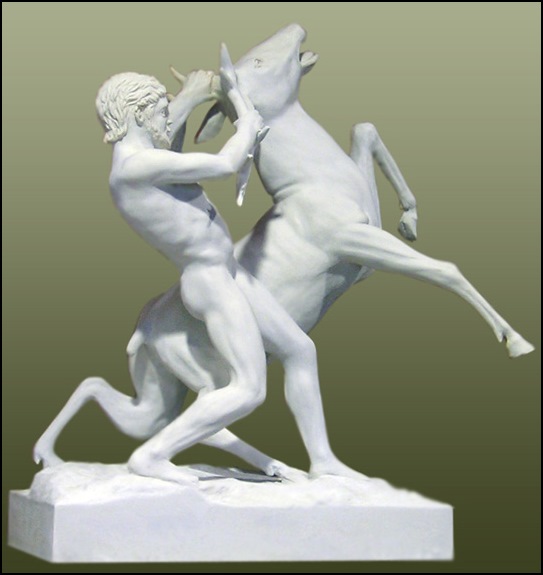
Hercules captures the Ceryneian Hind by J. M. Felix Magdalena, image by Jomafemag
A golden deer plays a large role in the Hindu epic ‘Ramayana’. While in the forest, Sita, Rama’s wife, asks Rama and his brother, Lakshmana, to go catch the golden deer for her. They agree and leave her to hunt and it is in their absence that Sita is kidnapped.
The Huichol people of Mexico also consider deer sacred. They make offerings to the Deer of the Maize to watch over their crops and to the Deer of the Peyote to guide them spiritually.
In the Scottish highlands, deer are considered noble creatures, just like the golden eagle and the salmon. Warriors and chiefs are often compared to stags and they are featured on many coats of arms.

Red Deer by Kev Chapman
More than six million deer are killed each year by hunters in the United States alone. Deer are one of the most commonly hunted animals in the world, along with geese, ducks, doves, foxes and squirrels.
Many deer are killed each year in North America from road collisions. In fact, of the 253,000 animal-vehicle collisions that occur yearly in the United States, about 90 percent involve deer.
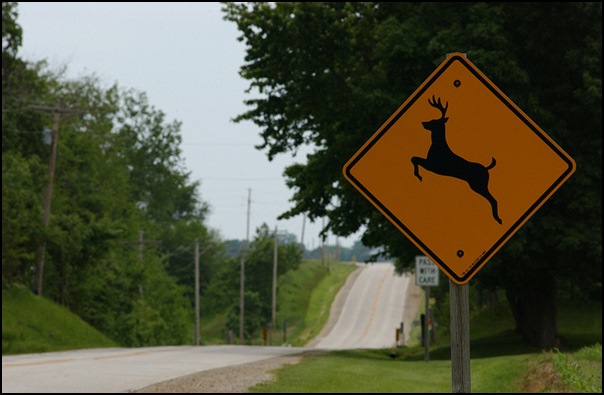
Caution Deer sign by State Farm
Final Facts
Bambi, who is probably the most famous fictional deer, was originally a roe deer. However, when Disney made the story into a film, Bambi was changed into a white-tailed deer.
In spite of their name, musk deer and mouse deer are not true deer, but belong to families of their own.
Deer always stay on guard against predators and so do not sleep deeply. Rather, they rest often in shaded areas or take several naps that do not last more than two hours.
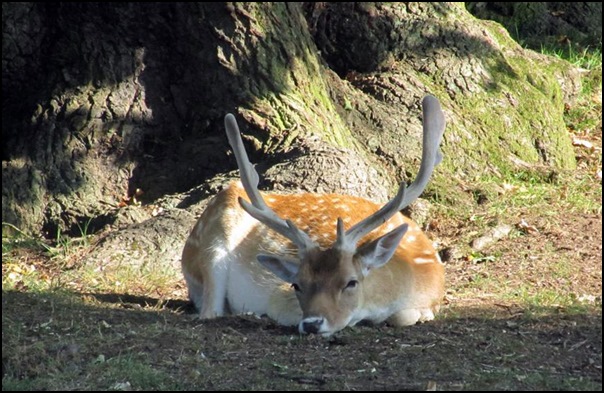
Doe eyed by Mike McSharry
Photo Credits
Front cover Taste of snow by Craig Lewis/USFWS cc2.0
www.flickr.com/photos/usfwshq/11088129305/
01 Red Deer by chapmankj75 creativecommons.org/licenses/by/2.0/
www.flickr.com/photos/25553993@N02/9664018793/
02 Antlers by internets_dairy cc2.0
www.flickr.com/photos/16339684@N00/2657090368/
03 Oh Dear! by DarrelBirkett creativecommons.org/licenses/by/2.0/
www.flickr.com/photos/darrelbirkett/4706939861/
04 Dicrocerus elegans Collection: Edouard Lartet creativecommons.org/licenses/by-sa/3.0/deed.en
05 Irish Elk by Sterilgutassistentin en.wikipedia.org/wiki/GNU_General_Public_License
06 Deer hoof by Joachim Bäcker
07 Deer Jumping Over Fence by Larry Lamsa cc2.0
www.flickr.com/photos/larry1732/5503074138/
08 Deer by rumpleteaser cc2.0
www.flickr.com/photos/rumpleteaser/6088647610/
09 Taste of snow by Craig Lewis/USFWS cc2.0
www.flickr.com/photos/usfwshq/11088129305/
10 Albino Barren Ground Caribou at Wagon Trails Animal Park by Brian0918 cc2.5 creativecommons.org/licenses/by-sa/2.5/deed.en
11 Red deer stag in Denmark by Bill Ebbesen cc3.0
12 Velvet antlers of a red deer stag by Mehmet Karatay cc3.0
13 Fallow deer with antler velvet peeling off by Stefan Ivanovich cc3.0
14 A red deer stag’s antlers covered with grass by Martin Falbisoner cc3.0
15 Red Deer at Ashton Court, Bristol, UK by Andrew Bennett cc2.0
16 Muntjac Deer Fawn (less than two hours old) by Peter Trimming creativecommons.org/licenses/by/2.0/
www.flickr.com/photos/peter-trimming/5787909660/
17 Fawn Under a tree by Walter Mains
18 A curious fawn on the meadow by LouisvilleUSACE creativecommons.org/licenses/by/2.0/
www.flickr.com/photos/louisvilleusace/4897426041/
19 Deer at Work by Earl McGehee cc2.0
www.flickr.com/photos/ejmc/5731755255/
20 Archangel reindeer 1890-1900 by Detroit Publishing Co
21 Peary caribou by L. David Mech NOAA cc3.0
22 Reindeer by Bjørn Christian Tørrissen cc3.0
23 A male moose takes a rest in a field during a light rainshower by Hagerty Ryan, U.S. Fish and Wildlife Service
24 Bull Moose by images.fws.gov
25 Indian Muntjac (Barking Deer) in Nagarahole Forest, India by Subramanya C K cc3.0
26 Rocky Mountain bull elk in Nebraska tall grass prairie by MONGO
27 Red deer stag in Glen Torridon, Scotland by Mehmet Karatay cc3.0
28 Formosan Sika Deer by Tempshill cc3.0
29 Tufted Deer, mature male with small tusks by Heush
30 Fallow deer at Avon Valley Country Park, England by Adrian Pingstone
31 Actaeon in Caserta by japiot cc3.0
32 Hercules captures the Ceryneian Hind by J. M. Felix Magdalena, image by Jomafemag cc3.0
33 Red Deer by Kev Chapman cc2.0
www.flickr.com/photos/25553993@N02/9667209740/
34 Caution Deer sign by State Farm cc2.0
www.flickr.com/photos/statefarm/9903040135/
35 Doe eyed by Mike McSharry cc2.0
www.flickr.com/photos/mikemcsharry/5985280419/




